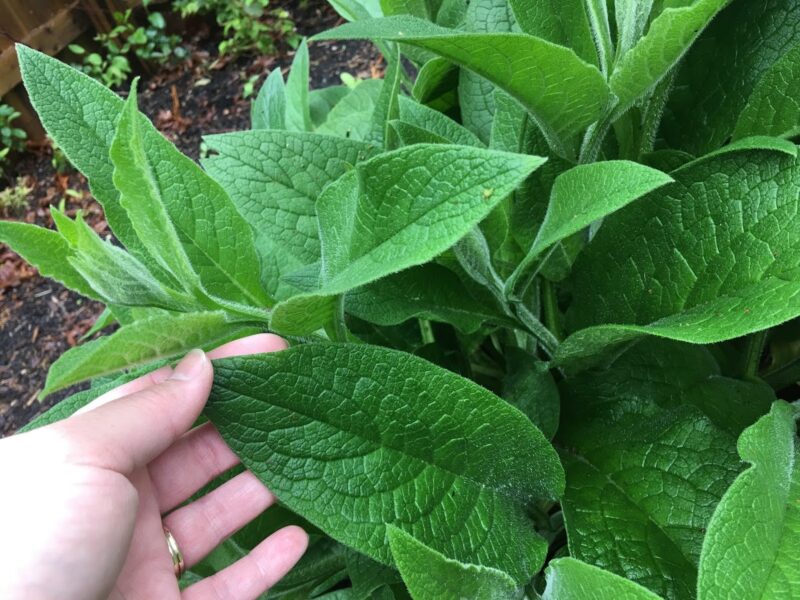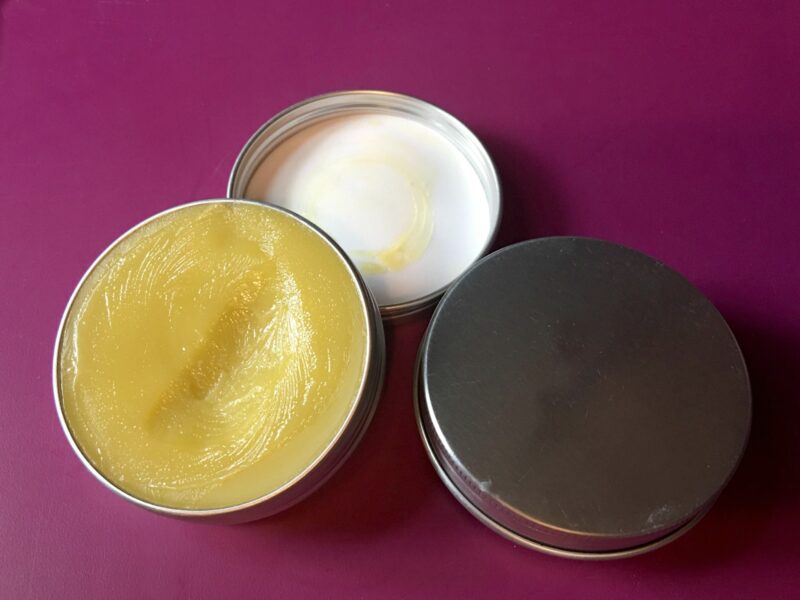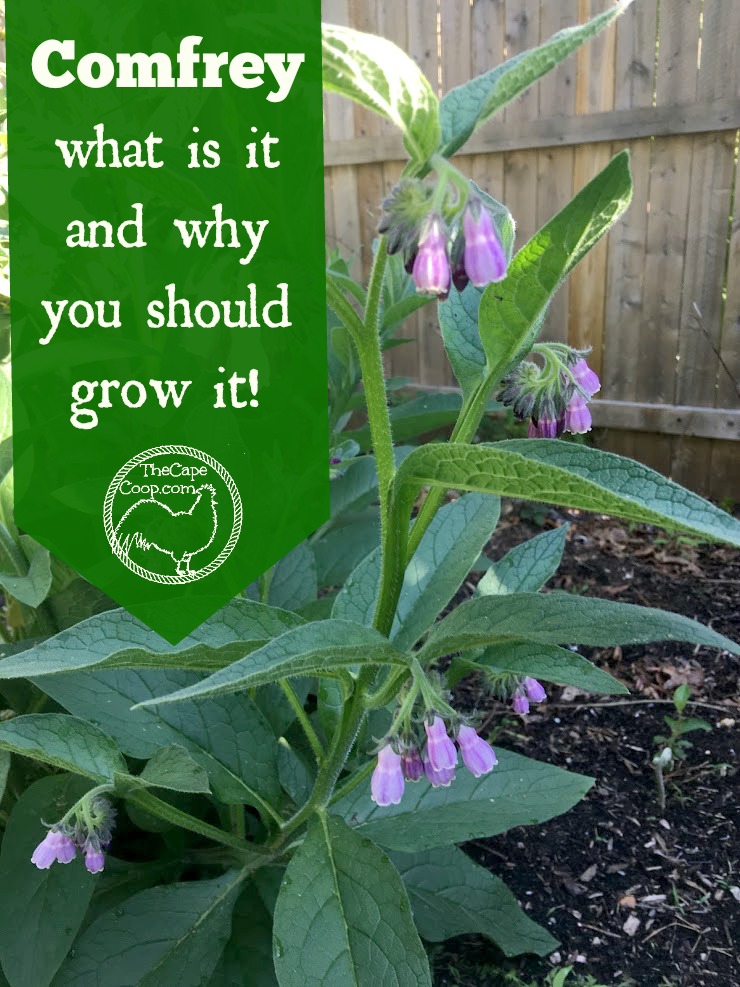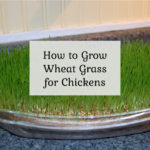---------------------------------------------------------
Thousands of years ago, comfrey was an important part of any herb garden. Today, modern gardeners and herbalists alike are rediscovering this easy-to-grow, easy-to-care-for, multi-purpose plant!
Comfrey is a tall, reliable perennial in USDA Hardiness Zones 4-9. When fully mature, under excellent conditions, it can be 3-6 feet tall and 2-4 feet wide. It could be considered a shrub and is a gorgeous way to get some height in your flower garden. Comfrey does best in full sun but can tolerate partial shade. Because of its deep tap root, it is extremely drought tolerant.
Once established, comfrey will basically take care of itself and can live for several decades before it begins to diminish. Lovely, large, deep green leaves are topped by blue, pink, purple, or white bell shaped flowers in mid spring to early summer. One word of warning, once you add comfrey to your garden, it can be hard to get rid of. Comfrey has a very deep & dense root structure (but you won’t want to get rid of it!).
Comfrey can sometimes be hard to find at your local nursery. I ordered mine online as 2-year bare root plants. The first year they were fairly small, but that second spring they were massive and have only gotten bigger and better with time!
Comfrey in the garden
As a spring bloomer with bright, attractive flowers, comfrey will attract lots of bees & other pollinators. This provides them with an important food source after the winter and ensures your garden will be on their “must visit” list all summer long!
The large, fast-growing leaves drape over the soil, providing a home for beneficial insects to live in & lay their eggs in, increasing your garden’s biodiversity.
With it’s deep tap root, comfrey is great for breaking up heavy clay soil.
Comfrey has been shown to help fruit trees grow stronger & produce better, so growing a plant at the base of your fruit trees is a great way to use comfrey in the garden. The leaves are very fast growing, so you can cut back your plant 4-5 times during the growing season to harvest.
Russian Comfrey vs True Comfrey
Comfrey can commonly be found in two types in the US (although there are dozens of varieties). Bocking 14 Russian comfrey (Symphytum x uplandicum) and True comfrey (Symphytum officinalis). Both types are great for fertilizer and medicinal uses. The biggest difference is that Russian comfrey is a hybrid plant that is sterile and doesn’t produce seeds. This makes it much easier to contain in a garden. True comfrey will produce seeds that easily spread and can end up being invasive in a small garden. If growing True comfrey, I would recommend growing it in containers. Russian comfrey usually grows faster and stronger.
Using comfrey as fertilizer
Comfrey leaves are very high in nitrogen, making them excellent for natural fertilizer and composting. Composted comfrey has similar NPK levels (nitrogen, phosphorus, potassium) as composted chicken manure so it can be a great option for people who can’t have livestock. Comfrey cuttings can be added to your compost bin as a “green” manure to balance out the “brown” materials (click here to read more about composting).
When you are putting your garden to bed in the fall, add some chopped comfrey leaves to the top layer of soil around perennials, fruit plants, or trees. The leaves will break down over the winter and give the plants a jump start in the spring. You can also grind dried leaves in a food processor until you get a powder. Lightly sprinkle the powder around your garden for a springtime pick me up before the growing season begins.
Comfrey for healing
Comfrey (Symphytum officinale) is a member of the borage (forget-me-not) family. The genus name Symphytum comes from the Greek symphis, meaning growing together of bones. The plant’s common name is derived from the Latin ‘con firma’ meaning knitting of bones. Another traditional name for Comfrey is, Knitbone.
Comfrey has a long-standing medicinal history. Ancient Greek physician Dioscorides, a well-known healer, pharmacologist & botanist in his day (around 40-90 AD), extensively wrote on comfrey’s properties and prescribed it for healing wounds, broken bones, as well as respiratory and gastrointestinal problems.
The natural healing properties of comfrey are due to its high levels of allantoin, which promotes cell growth. Allantoin is found in the placenta of pregnant mothers, helping her baby grow from just a few cells to a fully formed human being in just 9 months. It is also found in mother’s milk to support rapid infant growth. Comfrey leaves also contain rosmarinic acid to help relieve pain & inflammation. The leaves harvested in early spring before the flowers open, contain the highest alkaloid content, making it the ideal time for a medicinal harvest.
Comfrey has been shown to be toxic to the liver in high enough amounts when taken orally, so comfrey should only be used topically unless you are under the care of an experienced herbalist. You should not use it on large open wounds or if you are pregnant, nursing, have liver disease, or on certain medications.
A simple healing salve
To make a healing comfrey salve, harvest several large, healthy-looking leaves. Air dry or use a dehydrator until the leaves are crisp. You should always dry herbs first when making infusions so you don’t encourage mold growth.
Infuse about 1/2 cup of crushed leaves in 1 1/2 cups olive oil. Strain the leaves and add 4-5 teaspoons of beeswax pellets. Heat in a double boiler until beeswax is melted. Once melted, add 20 drops of rosemary essential oil. Pour into a container and allow to cool & harden. Use the salve on bug bites, scrapes, scratches, bruises, minor burns, back pain, joint pain, sprains, & sore muscles.









Melissa
Tuesday 29th of December 2020
What are the certain medications that it can’t be used with?
Liz
Wednesday 30th of December 2020
Hi Melissa, I am not an MD, so you should always consult with your doctor. But if you take any medications that are known to be harsh on your liver functions, comfrey should be avoided unless prescribed by a doctor. A few examples of liver taxing medications would include high doses of acetaminophen, erythromycin, fluconazole. You might be interested to check out the WebMD profile for comfrey: https://www.webmd.com/vitamins/ai/ingredientmono-295/comfrey
Nancy Gilsdorf
Saturday 8th of September 2018
I have a large beautiful comfrey growing under my front window. I would like to know if I can divide it? If so what is the best way and time of year?
Liz
Saturday 8th of September 2018
That is great! Comfrey is really easy to divide up and takes to replanting really well. Dig up a root/crown section about 2 inches wide and replant. The best time to do it is in spring when it's just starting to sprout out, but really you can do it all through the growing season and be just fine!
John
Tuesday 10th of July 2018
Can they be planted anytime of year?
Liz
Tuesday 10th of July 2018
If you are planting an established plant, you can plant anytime the soil can be worked (generally spring - fall). If you are starting from seeds, I would start them indoors in late winter for an early spring transplant. They do the most growing & flowering during late spring/early summer
Lou
Wednesday 4th of July 2018
Hi Liz I like the idea of the compressor salve. How long would you recommend steeping the leaves before straining - a week, a month? Thanks
Liz
Wednesday 4th of July 2018
The “better” way to do it is to let the leaves & oil steep for 2-3 weeks in a mason jar on a sunny windowsill. The quicker way is to put that mason jar of leaves & oil in a small sauce pot of simmering water for 3-4 hours. I have done both with great results!
Betsy Gast
Saturday 18th of November 2017
I live in Phoenix, AZ. I tried to grow comfrey, but it didn't do well. Tried some in the aquaponics, in the ground (full sun and part shade) Still it baked. Plenty of water as well. Besides the fact I live in the desert, what am I doing wrong?
Liz
Sunday 19th of November 2017
Hi Betsy, I have never gardened in the desert, so I don't have much advice in that area, but comfrey, like most plants, does need to stay evenly moist while establishing itself. Mine grows in part of my garden that gets full sun in the morning and partial sun the rest of the day and it loves it. Comfrey grows best in zones 4-9 and I suspect you are probably on the southern edge of that range. Comfrey is pretty tolerant of less than ideal soil, so I suspect it is just a sun/heat issue. Maybe try again in a shadier spot of your yard?